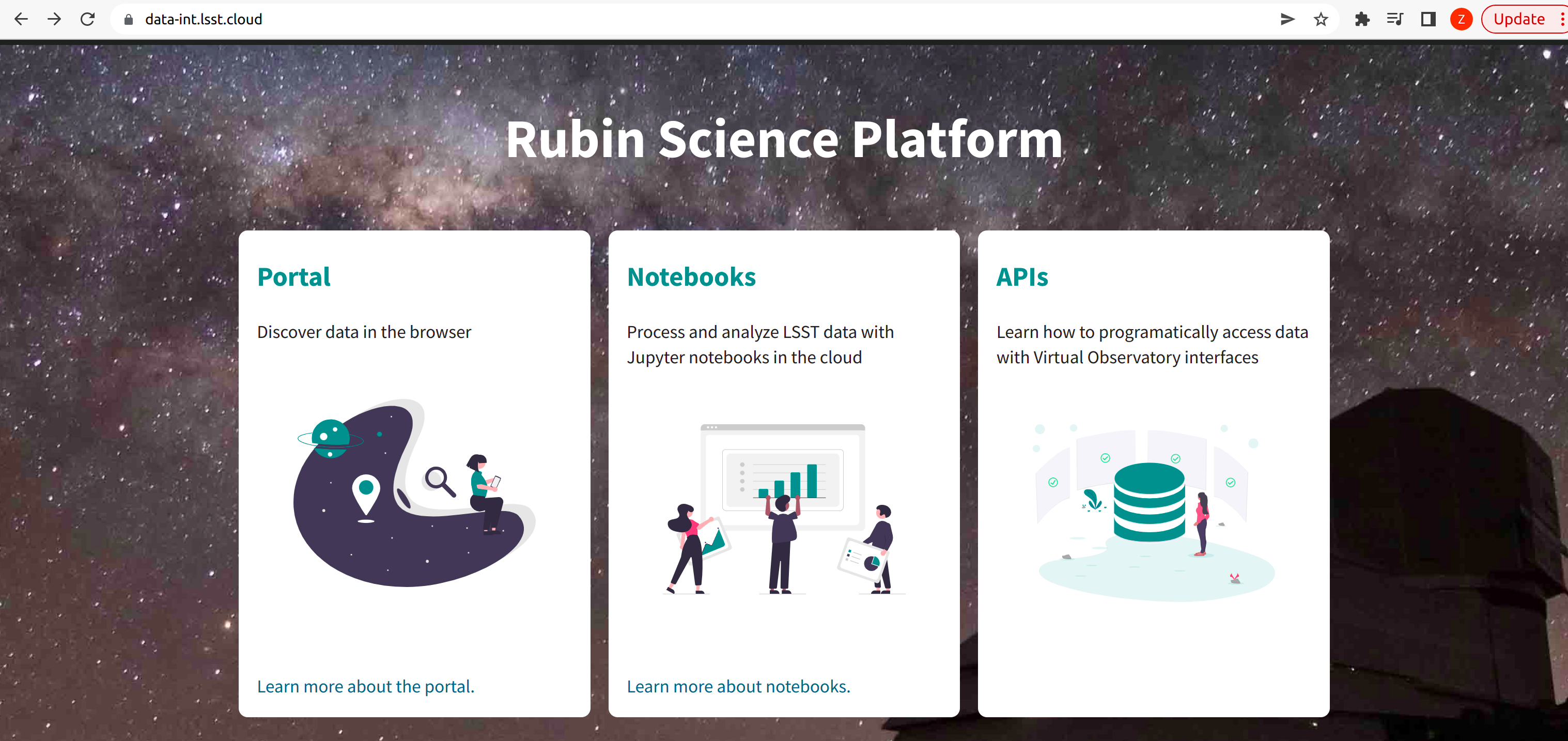How to submit a workflow (remotely)¶
Here are instructions how to submit a PanDA workflow to remote sites.
To submit a workflow locally, please check How to submit a workflow (locally or developer).
To submit a workflow to PanDA system, here are several general notes:
setup environment. To seupt workflows from USDF, FrDF and UKDF, we use the cvmfs to setup the environments. To submit workflows from IDF, we can only run remote submission.
YAML configuration. The YAML configuration for BPS submission.
butler configuration. For remote submission, users don’t need to configure butler. The site admin will configure it for you.
remote submission. In the remote submission, the YAML configuration files will be transfered to remote sites (Even the submission is from USDF to USDF is considered a remote submission). All steps, including the Quantum Graph generation are executed in the PanDA jobs. With remote submission, there will be no permission issue on Quantum Graph directory if a user is using the default configuration (without overwritting fileDistributionEndPoint).
Setup environment¶
Setup environment with CVMFS¶
The submit workflows from USDF, FrDF and UKDF, the CVMFS is available. Users can use CVMFS to setup the environments:
latest=$(ls -td /cvmfs/sw.lsst.eu/almalinux-x86_64/panda_env/v* | head -1)
source $latest/setup_lsst.sh <lsst stack version>
# source $latest/setup_lsst.sh w_2024_14 # for example
source $latest/setup_panda.sh
For LSST stack verion older than w_2024_14, this line below is required for remote submission:
source $latest/setup_bps.sh
Setup environment on IDF¶
The Rubin Science Platform (RSP) can be accessed from the JupyterLab notebook configured for the IDF at:
https://data-int.lsst.cloud/
Choose “Notebooks” and authorize lsst-sqre with your user credentials. After successful authentication, choose a cached image or the latest weekly version (recommended) from the drop down menu.

Open a terminal (menu File > New > Terminal).
On IDF, CVMFS is not available. However, on IDF, normal environments should already be setup. Users only need to run this command below after login to data-int.lsst.cloud or data.lsst.cloud.
setup lsst_distrib
IDF can only run remote submission currently, to submit workflows to USDF, FrDF or UKDF.
Ping PanDA Service¶
After setting up the environment, users can try to ping PanDA service to make sure the settings are ok.
If the BPS_WMS_SERVICE_CLASS is not set, set it through:
$> export BPS_WMS_SERVICE_CLASS=lsst.ctrl.bps.panda.PanDAService
Ping the PanDA system to check whether the service is ok:
$> bps ping
In this step, it will look for tokens for authorization. If you don’t have a token or you are not registered yet, please check User authentication.
Prepare YAML configuration¶
YAML configuration¶
As any other Rubin workflow submitted with BPS commands, PanDA based data processing requires a YAML configuration file. The YAML settings, common for different BPS plugins provided here:
https://pipelines.lsst.io/modules/lsst.ctrl.bps/quickstart.html#defining-a-submission
Later in this section we focus on PanDA specific and minimal set of the common settings supplied in the YAML with bps submit <config>.yaml command. They are:
- requestWalltime: 90000 maximum wall time on the execution node allowed to
run a single job in seconds
- numberOfRetries: number of attempts to successfully execute a job. Defult 5
- whenSaveJobQgraph: "NEVER" this parameter is mandatory because PanDA
plugin is currently supports only a single quantum graph file
distribution model
- fileDistributionEndPoint:
"file://${LSST_RUN_TEMP_SPACE}/{operator}/panda_cache_box/{payloadFolder}/{uniqProcName}/"
for USDF, UKDF and FrDF by default.
- payload_folder: payload name of the folder where the quantum graph
file will be stored
- runner_command. This is the command will be executed in container by
the Pilot instance. The ${{IN/L}} expression is the PanDA
substitution rule to be used during jobs generation.
- createQuantumGraph: '${CTRL_MPEXEC_DIR}/bin/pipetask qgraph -d
"{dataQuery}" -b {butlerConfig} -i {inCollection} -p
{pipelineYaml} -q {qgraphFile} {pipelineOptions}' this command
does not contain any PanDA specific parameters and executes at the
submission node on the local installation
- runQuantumCommand: '${CTRL_MPEXEC_DIR}/bin/pipetask --long-log run -b
{butlerConfig} --output-run {outCollection} --qgraph
{fileDistributionEndPoint}/{qgraphFile} --qgraph-id {qgraphId}
--qgraph-node-id {qgraphNodeId} --skip-init-writes --extend-run
--clobber-outputs --skip-existing' in this command we replace the
CTRL_MPEXEC_DIR on container_CTRL_MPEXEC_DIR because it will be
executed on the computation node in container
After implementing lazy variables there is not container release specific variables in the YAML file.
Site&Memory requirements in YAML files¶
Only request memory and let PanDA do the scheduling(do not define queue). Here is an example:
computeCloud: "US" computeSite: "SLAC" requestMemory: 2048 pipetask: pipetaskInit: requestMemory: 4000 executionButler: requestMemory: 4000Clustering memory requirements: Here is an example to put 4 jobs of pipetasks into a diffim cluster. In the example, memoryMultiplier is used to boost memory when a job failed because of running out of memory:
computeCloud: "US" computeSite: "SLAC" requestMemory: 2048 cluster: diffim: requestMemory: 8000 memoryMultiplier: 1.5 numberOfRetries: 3 executionButler: requestMemory: 4000Another example by specifying queues (Here a queue is defined):
computeCloud: "US" computeSite: "SLAC" requestMemory: 2048 pipetask: pipetaskInit: requestMemory: 4000 forcedPhotCoadd: # *requestMemory is still required here.* # *Otherwise it can be schedule to the merge* # *queue, but the requestMemory is still 2048* requestMemory: 4000 queue: "SLAC_Rubin_Merge"Another example to get multiple CPU Cores. Currently only the queue <site>_Rubin_Extra_Himem supports multi-cores. If the job needs multi-cores, the queue must be specified and requestCpus is needed. With multi-cores, the requestMemory is the total memory of all CPU cores:
computeCloud: "US" computeSite: "SLAC" requestMemory: 2048 pipetask: pipetaskInit: requestCpus: 2 queue: "SLAC_Rubin_Extra_Himem" requestMemory: 8000 forcedPhotCoadd: # *requestMemory is still required here.* # *Otherwise it can be schedule to the merge* # *queue, but the requestMemory is still 2048* requestMemory: 4000 queue: "SLAC_Rubin_Merge"
Example YAML configuration for remote submission¶
Here is an example for remote submission:
LSST_VERSION: w_2024_14
includeConfigs:
- ${CTRL_BPS_PANDA_DIR}/config/bps_panda_DF.yaml
- ${CTRL_BPS_PANDA_DIR}/config/bps_remote.yaml
pipelineYaml: "${DRP_PIPE_DIR}/pipelines/LSSTCam-imSim/DRP-test-med-1.yaml#isr"
# pipelineYaml: "${DRP_PIPE_DIR}/pipelines/LSSTCam-imSim/DRP-test-med-1.yaml#step1"
computeSite: SLAC
requestMemory: 4000
memoryMultiplier: 1.2
remoteBuild:
requestMemory: 4000
memoryMultiplier: 1.2
payload:
payloadName: test_DF_{computeSite}
inCollection: "2.2i/defaults"
# dataQuery: "instrument='LSSTCam-imSim' and skymap='DC2' and exposure in (214433) and detector=10"
dataQuery: "instrument='LSSTCam-imSim' and skymap='DC2' and exposure in (214433)"
# butlerConfig: panda-test-med-1 # butler configuration for FrDF and UKDF
butlerConfig: /repo/dc2 # butler configuration for USDF
Submit a workflow¶
Remote submission¶
Here are example commands to submit workflows to remote sites:
bps submit --compute-site SLAC test_remote.yaml
bps submit --compute-site CC-IN2P3 test_remote.yaml
bps submit --compute-site Lancs test_remote.yaml